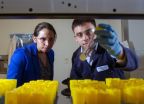(Press-News.org) WASHINGTON, D.C. -- Six massive glaciers in West Antarctica are moving faster than they did 40 years ago, causing more ice to discharge into the ocean and global sea level to rise, according to new research.
The amount of ice draining collectively from those half-dozen glaciers increased by 77 percent from 1973 to 2013, scientists report this month in Geophysical Research Letters, a journal of the American Geophysical Union. Pine Island Glacier, the most active of the studied glaciers, has accelerated by 75 percent in 40 years, according to the paper. Thwaites Glacier, the widest glacier, started to accelerate in 2006, following a decade of stability.
The study is the first to look at the ice coming off the six most active West Antarctic glaciers over such an extended time period, said Jeremie Mouginot, a glaciologist at University of California-Irvine (UC-Irvine) who co-authored the paper. Almost 10 percent of the world's sea-level rise per year comes from just these six glaciers, he said.
"What we found was a sustained increase in ice discharge—which has a significant impact on sea level rise," he said.
The researchers studied the Pine Island, Thwaites, Haynes, Smith, Pope and Kohler glaciers, all of which discharge ice into a vast bay known as the Amundsen Sea Embayment in West Antarctica.
The amount of ice released by these six glaciers each year is comparable to the amount of ice draining from the entire Greenland Ice Sheet annually, Mouginot said. If melted completely, the glaciers' disappearance would raise sea levels another 1.2 meters (four feet), according to co-author and UC-Irvine Professor Eric Rignot.
The decades of increasing speeds and ice loss are "a strong indication of a major, long-term leakage of ice into the ocean from that sector of Antarctica," noted Rignot.
"This region is considered the potential leak point for Antarctica because of the low seabed. The only thing holding it in is the ice shelf," said Robert Thomas, a glaciologist at the NASA Wallops Flight Facility, in Wallops Island, Va., who was not involved in the study. Ice shelves are platforms of permanent floating ice that form where glaciers meet the sea. In West Antarctica, ice shelves prevent the glaciers investigated in the study from slipping more rapidly into the ocean.
Mouginot and his colleagues used satellite data to look at sequential images of the glaciers from 1973 to 2013. The scientists then calculated how fast the ice was moving by tracking surface features, such as cracks in the ice, to determine the distance the glaciers traveled from month to month and year to year.
While the study considered the six glaciers collectively, it also revealed unprecedented change on the individual glacier level. Thwaites Glacier, the largest of the six with a width of 120 kilometers (75 miles), experienced a decade of near-stability until 2006, when its speed picked up by 0.8 kilometers (half a mile) per year – a 33 percent increase in speed, according to the study. This is the first time that such changes on Thwaites Glacier have been observed, said Mouginot.
Of all the glaciers in the study, Pine Island Glacier accelerated the most since 1973, increasing by 1.7 kilometers (one mile), per year. That's a 75 percent increase in speed from approximately 2.5 kilometers (1.5 miles) per year in 1973 to 4 kilometers (2.5 miles) per year in 2013.
Both Pine Island and Thwaites glaciers contribute the most to overall ice discharge—about three-fourths of the total amount documented in the study. However, scientists also documented even higher rates of increased discharge in some of the smaller glaciers. Smith and Pope Glaciers nearly tripled the amount of ice they drained into the ocean since 1973.
The research team also found that the Pine Island Glacier is accelerating along its entire drainage system—up to 230 kilometers (155 miles) inland from where it meets the ocean.
"This paper is important in showing that a glacier can actually 'feel' what is happening far downstream of itself," said Thomas. "It means that if you disturb the ice sheet near the coast, the glaciers will feel the push and rapidly respond hundreds of kilometers inland."
This finding suggests that glacier acceleration models may need to be reevaluated, Thomas added. Most current models only take into account isolated speed changes resulting from a local disturbance, rather than representing how these changes affect the glacier as a whole.
INFORMATION:
This research was funded by a grant from the NASA's Cryospheric Science Program and MEaSUREs program.
AGU: New study shows major increase in West Antarctic glacial loss
2014-03-26
ELSE PRESS RELEASES FROM THIS DATE:
Phloem production in Huanglongbing-affected citrus trees
2014-03-26
LAKE ALFRED, FL--Citrus Huanglongbing (citrus greening disease) is highly destructive and fast-spreading, contributing to a reduction in crop yields in Florida and threatening the future of the citrus industry worldwide. Once infected, trees never fully recover and there currently is no cure, although proper nutrient and water management appear to slow tree decline in some situations.
A bacterium called Candidatus Liberibacter asiaticus (CLas), vectored by the Asian citrus psyllid, is the presumed causal agent of the disease. Citrus trees affected by HLB exhibit a progressive ...
Study identifies key player in motor neuron death in Lou Gehrig's disease
2014-03-26
Amyotrophic lateral sclerosis, also known as Lou Gehrig's disease, is marked by a cascade of cellular and inflammatory events that weakens and kills vital motor neurons in the brain and spinal cord. The process is complex, involving cells that ordinarily protect the neurons from harm. Now, a new study by scientists in The Research Institute at Nationwide Children's Hospital points to a potential culprit in this good-cell-gone-bad scenario, a key step toward the ultimate goal of developing a treatment.
Motor neurons, or nerve cells, in the brain and spinal cord control ...
Repeat sternotomy for aortic valve replacement safe option for octogenarian patients
2014-03-26
Beverly, MA, March 26, 2014 – Surgical aortic valve replacement generally improves patients' symptoms and prolongs survival. However, the perceived risk of surgical aortic valve replacement in patients over 80 may result in surgery being denied or a recommendation for alternative therapy. Investigators at the Mayo Clinic challenge the way these patients have been managed. They report that repeat sternotomy in patients over 80 who have previously had coronary bypass graft surgery can be done with low risk. Their findings are published in the Journal of Thoracic and Cardiovascular ...
Prestorage conditioning, diphenylamine improve condition of 'honeycrisp' apple
2014-03-26
EAST LANSING, MI--Since the introduction of 'Honeycrisp' apples in 1991, the variety has become a consumer favorite for its unusual texture and delicious flavor. Honeycrisp has increased in popularity with growers as well; Michigan, New York, and Washington boast significant numbers of 'Honeycrisp' orchards. As the growing area dedicated to the variety has grown, the need to find better methods for improving storage performance has become more important to growers. Because 'Honeycrisp' is very sensitive to low temperatures and can be damaged by controlled-atmosphere conditions, ...
Nitrogen source determined significant for inflorescence development in Phalaenopsis
2014-03-26
TAIPEI, TAIWAN--The Phalaenopsis orchid, also known as the moth orchid, is the most important pot flower in terms of market value in the world's major floriculture markets. Because nitrogen significantly affects the growth and flowering of Phalaenopsis, nitrogen needs during flowering are of particular interest to growers. Researchers Hadi Susilo, Ying-Chun Peng, and Yao-Chien Alex Chang from the Department of Horticulture and Landscape Architecture at National Taiwan University published a study in the Journal of the American Society for Horticultural Science that determined ...
Engineered bacteria produce biofuel alternative for high-energy rocket fuel
2014-03-26
Researchers at the Georgia Institute of Technology and the Joint BioEnergy Institute have engineered a bacterium to synthesize pinene, a hydrocarbon produced by trees that could potentially replace high-energy fuels, such as JP-10, in missiles and other aerospace applications. With improvements in process efficiency, the biofuel could supplement limited supplies of petroleum-based JP-10, and might also facilitate development of a new generation of more powerful engines.
By inserting enzymes from trees into the bacterium, first author and Georgia Tech graduate student ...
Ancient sea creatures filtered food like modern whales
2014-03-26
The animals lived 520 million years ago during the Early Cambrian, a period known as the 'Cambrian Explosion' in which all the major animal groups and complex ecosystems suddenly appeared. Tamisiocaris belongs to a group of animals called anomalocarids, a type of early arthropod that included the largest and some of the most iconic animals of the Cambrian period. They swam using flaps down either side of the body and had large appendages in front of their mouths that they most likely used to capture larger prey, such as trilobites.
However, the newly discovered fossils ...
First ring system around asteroid
2014-03-26
The rings of Saturn are one of the most spectacular sights in the sky, and less prominent rings have also been found around the other giant planets. Despite many careful searches, no rings had been found around smaller objects orbiting the Sun in the Solar System. Now observations of the distant minor planet [1] (10199) Chariklo [2] as it passed in front of a star have shown that this object too is surrounded by two fine rings.
"We weren't looking for a ring and didn't think small bodies like Chariklo had them at all, so the discovery — and the amazing amountof detail ...
Gut metabolism changes -- not stomach size -- linked to success of vertical sleeve gastrectomy
2014-03-26
CINCINNATI—It's not the size of the stomach that causes weight loss after a specific type of bariatric surgery, but rather a change in the gut metabolism, say researchers from the University of Cincinnati (UC), the University of Gothenburg in Sweden and Cincinnati Children's Hospital Medical Center.
The scientists, publishing their results in the March 26, 2014, advanced online edition of Nature, have found that following vertical sleeve gastrectomy, there is a change in bile acids that bind to a nuclear receptor called FXR. In the absence of FXR, the researchers showed, ...
Some breast cancer tumors hijack patient epigenetic machinery to evade drug therapy
2014-03-26
PITTSBURGH, March 26, 2014 – A breast cancer therapy that blocks estrogen synthesis to activate cancer-killing genes sometimes loses its effectiveness because the cancer takes over epigenetic mechanisms, including permanent DNA modifications in the patient's tumor, once again allowing tumor growth, according to an international team headed by the University of Pittsburgh Cancer Institute (UPCI).
The finding warrants research into adding drugs that could prevent the cancer from hijacking patients' repressive gene regulatory machinery, which might allow the original therapy ...



